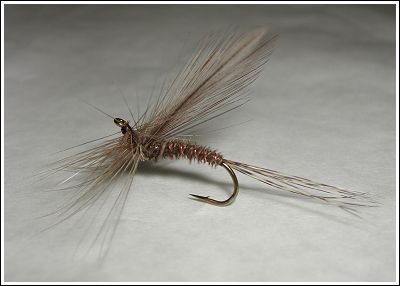|
Hook Bent
By Agostino Roncallo

When I began to construct artificial
flies, I built my flies with system hackling, until I knew the parachute
assembly. Immediately I appreciated its imitative and structural
characteristics and tried to improve its robustness.
With the creation of "My Parachute" I
think that I have get what I wanted.
Another montage that I liked was that of
the well-known French fly tyer Aimé Devaux.
In his montage, the beards of the cock
hackle are pushed forward slanting downward to provide better support to
fly over the water.

I also tried to improve this montage and
produced the "Forward Split hackles" present in my book "Magic in the
CDC." For many years
I hoped to create a fly that had the best features of both assembly and
I think I to be able bending a hook shank right.
I took a right hook with long stem and
gradually bent it down, starting from two parts of its length.
Once the bending down, bent upward at an
angle of about 45 °, the section of the stem near the eye.

In practice, I fell down the stem as I
bend it up, with the result that the eye came to be in line with the
axis that had the stem before being bent.
In this way, the penetration of the hook
was not altered.
Dressing 1. On
the curve of the hook shaped, fixed the code and materials to build the
body of the fly. 2.
I carry the body of the fly.
3. Down with hook and in the terminal
block so that the hook facing up to be in the horizontal position. Fix
the hook in the crook of two bits of chicken or rooster hackles, to
imitate the wings.
4. Fixed next to the wings of a rooster hackle
5. Wrap the hackle around the shank of
starting to wrap one or two turns of hackle behind the wings. Fixed the
hackle close to the eyelid and cut the excess.
6. Node and run the final assembly of the
fly is finished.

If we look at the fly we see that it have
the main characteristics of the Devaux assembly and parachute.
The cock's hackle beards are facing
forward, as in the assembly Devaux, but while in that assembly, the
barbs are arranged in a forward cone, then the artificial fly can rotate
and fall of water, when mounted on this hook, the beards rooster form a
collar similar to the parachute montage, which sits leaned forward on
the water and prevent the rotation of the fly with a consequent fall
off.

From the point of view esthetic and
imitative I am satisfied of the fly: sits on water in the same position
assumed by the dun when they are with the flow and, if it was built
with the right proportions and the right colors, it's easy to mistake it
for a true insect.


Text and
photos by Agostino Roncallo © 2010
|